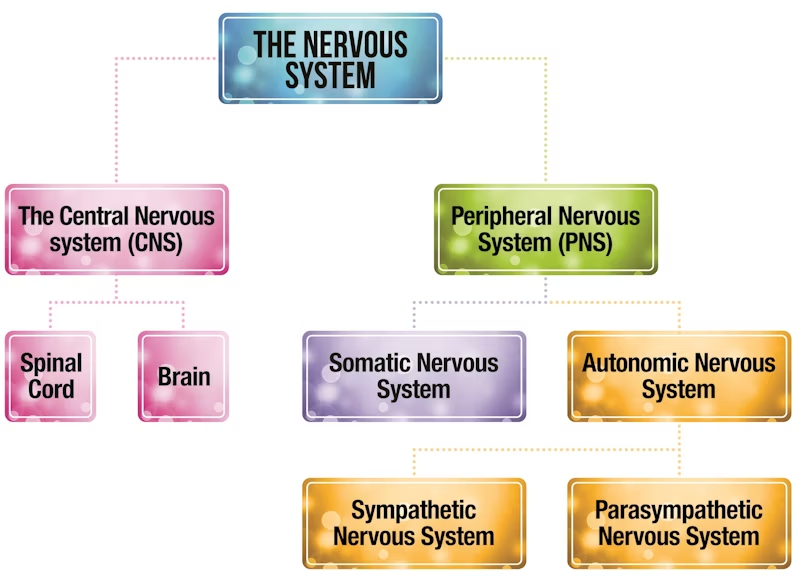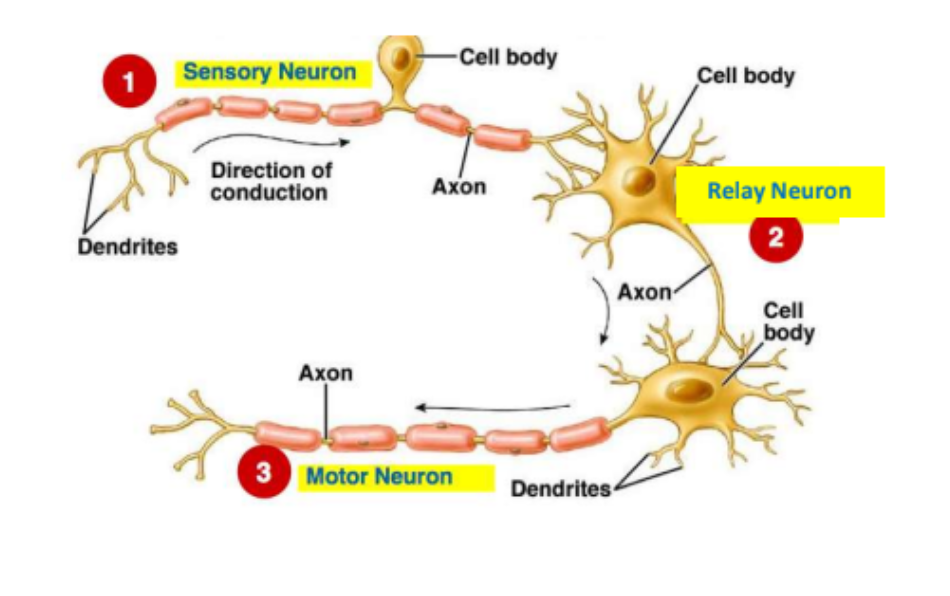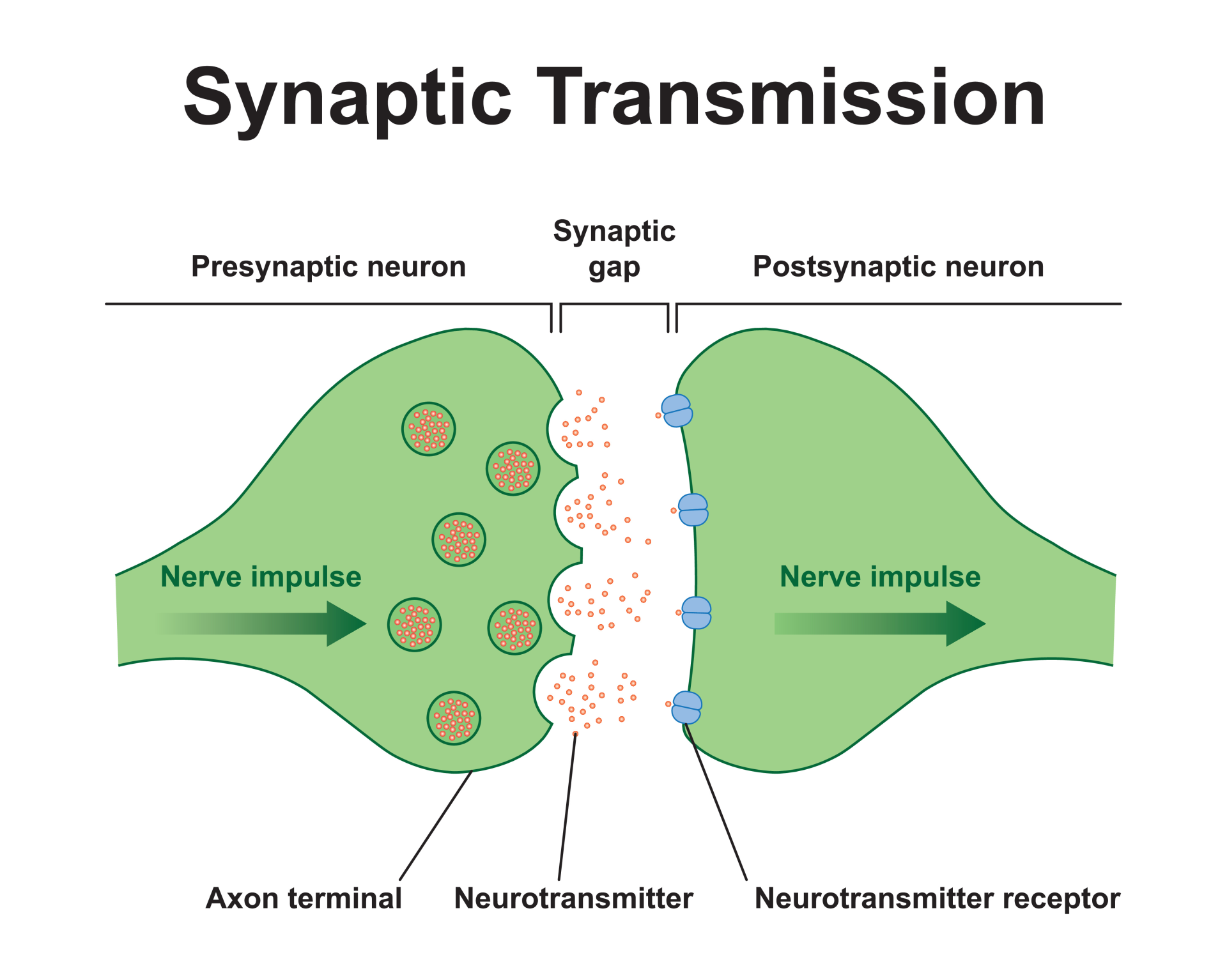Biopsychology
1/34
There's no tags or description
Looks like no tags are added yet.
Name | Mastery | Learn | Test | Matching | Spaced |
|---|
No study sessions yet.
35 Terms
structure of the nervous system

central nervous system
brain
spinal cord
coordinator of everything
receives information from the environment
processes, makes decisions and makes these actually happen
brain: decision maker
spinal cord: major connection to the peripheral. does reflex actions
peripheral nervous system
millions of neurons transmit messages to and from the CNS
then subdivided into the autonomic and the somatic
somatic nervous system
voluntary, conscious, deliberate actions
muscle coordination and info from sensory receptors
autonomic nervous system
involuntary, unconscious actions
e.g. breathing, HR, digestion
sympathetic and parasympathetic (antagonistic pair)
sympathetic
gut: slows digestion
salivary glands: inhibits production
heart: increases rate
eye: dilates pupil
lungs: dilates bronchi
parasympathetic
increases digestion
increases saliva
decreases HR
constricts pupil
constrict bronchi
flight or fight response
the hypothalamus identifies a threat and instructs the sympathetic system to act.
stress hormone adrenaline is released from the adrenal glands into the blood stream
adrenaline prompts a number of physical changes in the body to prepare for fight or flight
following the fight or flight response the parasympathetic nervous system is activated to return the body back to a normal resting rate e.g. slows HR, breathing rate, reduces blood pressure
evaluating the fight or flight response
useful in evolutionary terms. when we need energy to deal with the situation it prepares us to have the energy to run away or stay and fight.
→ not useful for stressers that do not require physical activity e.g. modern ones like debt. these bodily changes can be unhelpful and lead to illness.
research in this area of flight and fight is gender biased (alpha- androcentric). the research is only done on male Ps then generalised to females as well. females are more likely to show tend and befriend response. produces less adrenaline so gather together and support more.
the endocrine system (glands and their use)
pituitary
thyroid
adrenal
ovaries
works alongside the nervous system to control glands which release hormones into the bloodstream.
→ pituitary (base of brain under hypothalamus)
stimulated other endocrine glands e.g. controls growth, blood pressure, water levels
oxytocin (childbirth and breastfeeding), vasopressin (balances salt and water)
- thyroid (front of neck)
controls speed of metabolism,breathing, temperature, brain development
thyroxine
- adrenal (top of kidneys)
regulates metabolism, blood pressure, development of sexual characteristics
cortisol: controls body’s use of fats, proteins, carbs and the blood pressure
adrenaline: flight or fight- increases HR etc
- ovaries (either side of uterus)
produces and stores eggs
oestrogen- breasts, wide hips, thickens uterine lining
progesterone- thickens uterine linings, breasts to produce milk
types of neurons
sensory: carries messages from PNS to CNS. long dendrites and short axons.
relay: connect sensory to motor (or other relay). short dendrites and short axons
motor: connect CNS to affects like muscles and glands. short dendrites and long axons
structure of a neuron
cell body with nucleus that contains genetic material
dendrites → axon → terminal buttons
myelin sheath protects and speeds up impulse. has nodes of ranvier to force it to ‘jump’

reflex arc
uses relay neurons in spinal cord to produce automatic response to environmental issues which need a quick response e.g. moving hand from heat
detected by sense organs in PNS which convey message along sensory neuron
message researches CNS → relay neuron → motor neuron
then carries messages to effectors such as a muscle
electrical transmission (done within neurons)
in a resting state the inside of the neuron is negatively charged compared to the outside
when activated by a stimulus, the inside becomes positively charged for a split second causing an action potential to occur creating an electrical impulse
this travels down the axon towards the end of the neuron (and triggers the release of neurotransmitters)
chemical transmission (done between neurons)
each neuron is separated from the next by a tiny gap called a synapse
signals between neurons are transmitted chemically
neurotransmitters are released from tiny sacs called synaptic vesicles.
they mostly diffuse across the synapse to the next neuron
(or are broken down by enzymes or reabsorbed into vesicles)
once a neurotransmitter crosses the gap it is taken up by the receptor sites and converted back into electrical impulses.
each neurotransmitter has its own specific molecular structure that fits to receptor site (lock and key)

excitation
neurotransmitter increases the positive charge of the post synaptic neuron which increases the likelihood that the post synaptic neuron will pass on the electrical impulse e.g. adrenaline
inhibition
neurotransmitter increases the negative charge of the post synaptic neuron which decreases the likelihood that the post synaptic neuron will pass on the electrical impulse e.g. serotonin
summation
whether a postsynaptic neuron fires
sum of excitatory and inhibitory influences
net effect either excitatory or inhibitory
Localisation
specific areas of the brain are associated with particular physical and psychological functions (rather than holistic- the brain working as a whole)
Lateralisation
dominance of one hemisphere of the brain for particular physical and psychological functions e.g. language areas are only found on the left. (mostly 2 hemispheres are quite similar)
3 concentric layers
central core
Central core/ brain stem
regulated most primitive and involuntary behaviours e.g. breathing, sleeping, sneezing
includes structures like the hypothalamus in the mid brain
regulates eating, drinking and the endocrine system to maintain homeostasis (how the body keeps a constant physiological state)
3 concentric layers
limbic system
controls our emotions
interconnected with the hypothalamus
contains structures like hippocampus which is associated with memory
3 concentric layers
cerebrum
regulates our higher intellectual processes
outermost layer, cerebral cortex: appears grey due to location of cell bodies ‘ grey matter’
each sensory system sends messages to and from cerebral cortex
middle of left and right hemispheres connected by corpus callosum: can convey messages to both left and right
each hemisphere then further divided into four lobes
temporal lobe
auditory
location for auditory ability and memory acquisition
auditory centres
cochlea: sound waves converted to nerve impulses
auditory nerve
brain stem- decodes duration and intensity of sound
thalamus- further processing
auditory cortex- recognises and generates an appropriate response
Occipital lobe
visual
location for vision
light enters and strikes photoreceptors (rods and cones) in retina
nerve impulses to optic nerve
nerve impulses to thalamus
some to other areas to coordinate circadian rhythms
visual cortex- contains areas that process different types of visual information such as colour, shape and movement.
right receives input from left hand side of the visual field and vice versa
Parietal lobe
somatosensory
location for sensory information and coordination
somatosensory cortex: detects sensory events from different regions in the body. uses sensory information from the skin to produce sensations such as touch, pressure and pain.
cortex on one side of the brain receives information from opposite side of the body
Frontal lobe
Motor
awareness of interactions with environment, consciousness and motor cortex
motor cortex: responsible for voluntary motor movements. in the right hemisphere the cortex controls muscles on left and vice versa. different parts control different parts of the body, and is arrange logically (part that controls foot near part that control leg)
damage to this area results in impaired movements
Language centres
Broca’s
Paul Broca, French Neurosurgeon
treated a patient who was only able to say ‘tan’ but did understand language
also studied 8 other patients who h\d similar language deficits along with lesions in their left frontal hemisphere (people with damage on right did not have the same issues)
identified language centres in back portion on left frontal lobe that is critical for speech production
near where the mouth, tongue and vocal cords are controlled
Neuroscientists found when people do cognitive tasks (unrelated to language) their Broca’s area is active
Federonka: 1 part involved in language and 2 responds to demanding cognitive tasks like maths problems
Language centres
Wernicke’s
German neurologist
back left temporal lobe
patient with legion’s on Wernicke’s area could speak but could not understand language
sensory area- responsible for auditory and visual input processing
neural loop runs between Wernicke’s and Broca’s
Evaluating localisation of the brain
evidence from neurosurgery- damage to areas of brain linked to mental disorders
neurosurgery treats mental disorders by targeting specific areas of the brain that may be involved.
DOUGHERTY: 44 people who had had cingulotomy (isolate cingulate gyrus involved in OCD) after 32 weeks: 30% had successful response, 14% partial response
behaviours in mental disorders are localised.
evidence from brain scans.
PETERSON: used brain scans to demonstrate how Wernicke’s area was active during listening task and Broca’s during a reading task.
BRACKNER + PETERSON: semantic and episodic memories reside in different parts of the prefrontal cortex.
confirms localised areas for everyday behaviours.
→ LASHLEY: removed areas of cortex (10%-50%) in rats learning route through maze. no area was proven to be more important than any other area in terms of rat’s ability to learn the route. more about the process of learning and needing more of the cortex. more holistic as emphasises involvement of the whole brain.
When the brain has been damaged and a function has been impacted the rest of the brain helps to recover it. Law of equipotentiality- surviving brain circuits chip in so the same function can be achieved e.g. stroke victim’s recovery- learning relies on the whole brain.
Language not just localised to Broca’s and Wernicke’s area
only 2% of researchers believe it is completely controlled by these areas.
advances in brain imaging e.g, fMRI means neural processes can be studied with more clarity.
language function distributed more holistically in brain e.g. language streams across cortex- brain regions in right hemisphere, thalamus.
holistic so contradicts localisation
lateralisation
and how stimuli is processed
the 2 hemispheres of the brain are functionally different and certain mental processes and behaviours are mainly controlled by 1 hemisphere rather than the other
→ most stimuli is processed contralaterally meaning if stimuli enters on the left it is processed in the right hemisphere and vice versa.
analyser and synthesiser for language
analyser: left is dominant in language e.g. broca’s and wernicke’s
synthesiser: right hemisphere can only produce basic words and phrases but provides emotional context.
commissurotomy
the corpus callosum is severed
often for people with severe epilepsy
the main communication line between each hemisphere is removed
so the information can not be conveyed from 1 hemisphere to the other. (cannot generate whole picture)
split brain research, sperry
image usually projected on Ps right visual field is processed by the left hemisphere and then vice versa.
for people with a commissurotomy the information cannot be conveyed between each hemisphere.
therefore sperry could see extent to which 2 hemisphere were specialised for certain functions and whether the hemispheres performed certain tasks individually.
→ investigated hemispheric lateralisation with 11 split brain patients
Sperry’s research methods
describe what you see
recognition by touch
describe what you see
picture presented to the left visual field (processed by right): patient COULD NOT describe what was shown or said nothing was present.
picture presented to the right visual field (processed by left); patient COULD describe what they saw.
recognition by touch
object placed in the left hand (processed by right): COULD NOT describe what they felt but could identify by selecting similar appropriate object from a group of objects.
object placed in right hand (processed by left): COULD describe what they felt and could also identify object by selecting similar appropriate objects from a group of objects.
evaluating sperry’s research
even in connected brains the 2 hemispheres process information differently
FINK: used PET scans to identify which brain areas were active in visual processing task
Ps were asked to look at big elements of an image (e.g. whole forest) and right hemisphere was much more active.
when focusing on finer details (e.g. individual trees), specific areas of the left hemisphere were more dominant
→ for visual processing, there is lateralisation
scientific methodology due to high control: presented visual stimulus for short amount of time to ensure only one hemisphere was receiving at a time high internal validity.
lacking generalisability as Ps were compared to neurological control group where none had epilepsy. this is a major confounding variable as differences/ cognitive abilities may be due to epilepsy not split brain
there is an exaggerated difference between hemispheres, when a situation requires it e.g. damage from illness or trauma, function can be effectively performed by another hemisphere (plasticity)